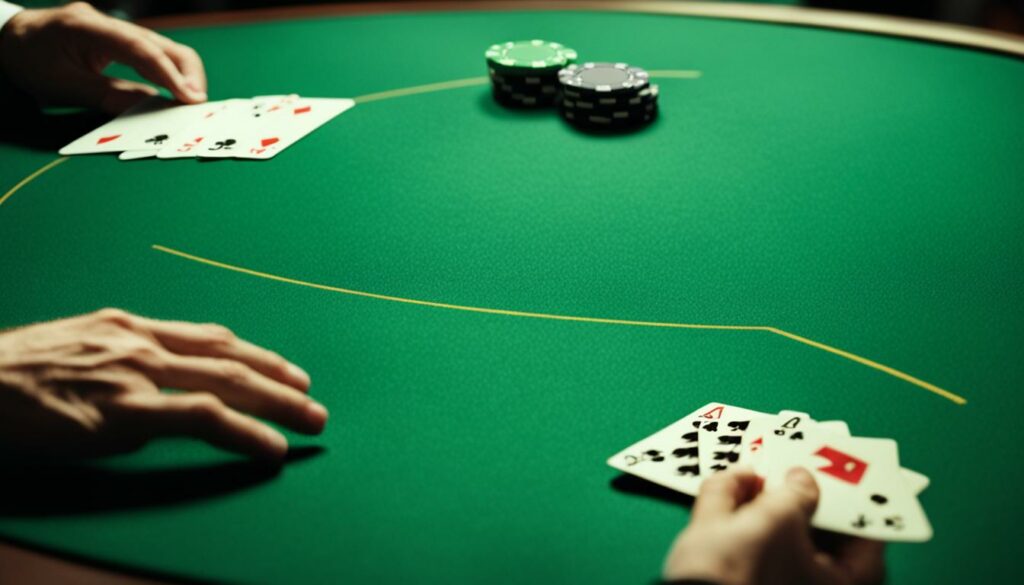
Have you ever wondered how often casinos shuffle the cards in blackjack games? The shuffle frequency in blackjack is an important factor to consider when developing your game strategy. In this article, we will delve into the topic of shuffle frequency and explore why it matters.
Understanding the shuffle frequency can give you valuable insights into the game flow and randomness of the cards. It can influence various aspects of your gameplay, including card counting techniques and card sequencing strategies.
So, how often do casinos shuffle blackjack? The casino blackjack shuffling frequency can vary depending on several factors, such as the number of decks used, the house rules, and the preferences of the casino.
In the next sections, we will explore how casinos determine the timing for shuffling the cards, the role of the blackjack dealer in the shuffling process, and the different shuffling practices employed by casinos. Additionally, we will discuss the effects of shuffle frequency on your game strategy.
Stay tuned to learn more about the fascinating world of shuffle frequency in casino blackjack!
Determining Blackjack Shuffle Timing
When playing blackjack at a casino, have you ever wondered how often the cards are shuffled? The shuffle frequency in blackjack can vary depending on several factors that casinos take into account. In this section, we will explore the process behind determining the shuffle timing in blackjack games.
One of the main factors that influence the shuffle frequency is the number of decks used in the game. Casinos may use anywhere from one to eight decks in a blackjack shoe. Generally, the more decks in play, the longer it takes for the cards to be reshuffled. This allows for more hands to be played before a shuffle is required.
The house rules also play a role in determining the shuffle timing. Some casinos may have specific guidelines regarding when the cards should be reshuffled. For example, they may shuffle the cards after a certain number of rounds or when a specific percentage of the shoe has been played. These rules ensure fairness and prevent any potential advantage players may gain from tracking the cards.
Additionally, the preferences of the casino itself can impact the shuffle frequency. Casinos may adjust the shuffle timing based on factors such as player volume, table turnover rate, and overall game flow. By finding the right balance between game pace and shuffling, the casino aims to provide an enjoyable experience for players while maintaining fairness and integrity.
Understanding how casinos determine the shuffle timing in blackjack can give you insights into the dynamics of the game. By being aware of the factors that influence shuffle frequency – such as the number of decks, house rules, and casino preferences – you can better strategize your gameplay and adapt accordingly.
Next, let’s take a closer look at the role of the blackjack dealer in shuffling the cards and its impact on the game.
The Role of the Blackjack Dealer in Shuffling
In a game of blackjack, the role of the dealer extends beyond dealing cards. One of their significant responsibilities is shuffling the cards to maintain fairness and randomness in the game. Understanding the blackjack dealer’s role in shuffling is essential for players who aim to develop effective strategies.
The blackjack dealer shuffle interval refers to the timing and frequency at which the dealer shuffles the cards during gameplay. This interval plays a crucial role in determining the flow of the game and the unpredictability of the cards.
During each shuffle, the dealer collects the played cards, ensuring they are thoroughly mixed with the remaining cards in the deck. This process helps prevent card sequencing and keeps the game fair and unbiased.
The shuffle interval is not fixed and may vary depending on various factors, including the casino’s rules and preferences. However, there is a general guideline followed by most dealers in regards to blackjack shuffle timing. Typically, dealers shuffle the cards after every round or when a specific number of rounds have been completed.
Shuffling Practices in Casino Blackjack
When it comes to casino blackjack, shuffling practices play a crucial role in maintaining fairness and randomness in the game. Players often wonder how often the cards are shuffled in blackjack and what methods casinos employ to ensure a level playing field.
Let’s dive into the world of shuffling in casino blackjack and explore the various techniques used by casinos to shuffle the cards:
Hand Shuffles
Hand shuffling is the traditional method employed in many casinos. It involves the dealer manually shuffling the cards by mixing them thoroughly to create a randomized deck. Hand shuffles are often favored for their perceived fairness and level of control.
Machine Shuffles
In modern casinos, machine shuffles have become increasingly common. These sophisticated shuffling machines use automated mechanisms to shuffle multiple decks quickly and efficiently. Machine shuffles ensure consistency in the shuffling process and reduce the likelihood of human error.
Continuous Shuffling Machines (CSMs)
Continuous shuffling machines (CSMs) have gained popularity in recent years. These devices automatically shuffle the cards after each hand, eliminating the need for manual shuffling by the dealer. CSMs offer a higher shuffling frequency, resulting in a more random distribution of cards and making it challenging for players to track card sequences.
It’s important to note that different casinos may adopt different shuffling practices based on their policies and player preferences. Some casinos may shuffle the cards more frequently than others, while some may use specific shuffling methods for certain blackjack variants.
Understanding these shuffling practices can help players develop effective strategies and adjust their gameplay accordingly. While more frequent shuffling can hinder card counting techniques, it also prevents card sequencing strategies from being reliably effective.
Stay tuned for the next section, where we explore the effects of shuffle frequency on game strategy. We’ll examine how these shuffling practices impact player decisions and betting strategies to help you gain an edge at the blackjack table.

| Shuffling Method | Pros | Cons |
|---|---|---|
| Hand Shuffles | Perceived fairness and control over shuffling process | Time-consuming, potential for human error |
| Machine Shuffles | Efficient and consistent shuffling, reduced human error | Less control, dependence on machines |
| Continuous Shuffling Machines (CSMs) | Higher shuffling frequency, random distribution of cards | Challenges card counting techniques, eliminates card sequencing strategies |
Effects of Shuffle Frequency on Game Strategy
When it comes to playing blackjack, understanding the shuffle frequency used by casinos can have a significant impact on your game strategy. The frequency at which the cards are shuffled can determine the effectiveness of various techniques and approaches, ultimately influencing your chances of winning. Let’s explore the implications of shuffle frequency in blackjack and how it can shape your gameplay.
The Impact on Card Counting Techniques
One of the most well-known strategies in blackjack is card counting, a technique that allows players to keep track of the high and low-value cards left in the deck. By monitoring the ratio of high to low cards, players can make informed decisions about their bets and gameplay, increasing their odds of winning. However, frequent shuffling can hinder the effectiveness of card counting.
When casinos shuffle the cards more frequently, it reduces the number of cards available for counting. This makes it challenging for players to gather enough information to make accurate predictions and adjust their strategy accordingly. As a result, the impact of card counting is diminished, and players might find it harder to gain an advantage.
The Implication for Card Sequencing Strategies
Another approach that players may employ in blackjack is card sequencing, which involves tracking specific sequences or patterns in the shuffled deck. By identifying these patterns, players can anticipate which cards are likely to appear next, potentially allowing them to make more strategic decisions.
However, frequent shuffling disrupts any patterns or sequences that players might observe. With each shuffle, the order of the cards is completely rearranged, eliminating any advantage players may have gained through card sequencing strategies. Therefore, players must adapt their approach and rely on other techniques when shuffle frequency is high.
Overall, the effects of shuffle frequency on game strategy in blackjack are both challenging and nuanced. While more frequent shuffling may make it difficult to employ certain techniques like card counting and card sequencing, it also prevents others from exploiting these strategies. Players need to consider the trade-offs and choose their approach accordingly.
| Shuffle Frequency | Effect on Card Counting | Effect on Card Sequencing |
|---|---|---|
| Infrequent | Allows for more effective card counting | Possible to identify and utilize card sequencing strategies |
| Frequent | Makes card counting less effective | Disrupts any observed card sequencing patterns |
Adapting to the shuffle frequency in blackjack is an essential skill for any serious player. By understanding the implications of shuffle frequency on different strategies, you can adjust your gameplay and make more informed decisions at the table.

Conclusion
Understanding the shuffle frequency in casino blackjack is crucial for developing a successful game plan. By comprehending the factors that influence shuffle timing, the role of the dealer, and the impact on game strategy, you can make informed decisions and enhance your chances of winning at the blackjack table.
Shuffle frequency is determined by various factors, including the number of decks used, house rules, and the casino’s preferences. It is important to note that more frequent shuffling can hinder card counting techniques, but it also helps prevent card sequencing strategies.
As you navigate the world of casino blackjack, familiarize yourself with the different shuffling practices employed by casinos, such as hand shuffles, machine shuffles, and continuous shuffling machines (CSMs). Each method has its own implications for the randomness of the cards and the flow of the game.
Ultimately, adapting your game strategy based on shuffle frequency is key. By understanding how frequently the cards are shuffled and the impact it has on card counting and sequencing, you can adjust your approach and increase your chances of success. So, the next time you hit the blackjack table, keep these factors in mind and play strategically!
